PORTED INTAKE MANIFOLDS UPDATE
8-27-07
WE NAME NAMES! (Some of them, anyway)
This report is a follow-up to our March 2006 tech article on intake manifold flow-testing. Further testing has provided more information, clarifying some of our original theories and blowing some others out of the water. Our tests are based on flowbench, dyno, and dragstrip results.
One mistake that we have seen is how much the intake manifolds have been misunderstood, left out or relegated to an afterthought when engine combinations are developed. Racers will spend thousands of dollars on an engine and stick on some 10 or 20 year-old manifold design they got at a swap meet.
Maybe I shouldnt be surprised at this situation, because there is precious little information on manifolds or actually modified manifolds available. Even Chevy magazines do very little with manifold information other than run articles featuring new ones. The few articles that have been printed have dealt with swapping from one to another until you found the best one, or flow testing 1 port only.
As far as I can determine, Wilson Manifold is the only place in the country that specializes in intake manifolds. Guess what they work on? This lack of modified intakes is somewhat ironic as there may be 50-100 places making exhaust systems. Nevertheless, we are committed to providing the best possible intake manifolds for Mopars in the country.
One of the more important findings was that the manifold must flow 16%-20% more than the cylinder head, when using gasoline, or it will become a restriction to the entire intake system. Originally we thought that 4%-6% would be enough (see, we make mistakes so you dont have to). The sad part is that this is what we have had to live with for the past 20 or 30 years. Even today there are very few manifolds available for Chrysler that dont restrict the airflow, especially when using the newer aluminum heads. The problem gets even worse when using ported heads. Having said that let me qualify a few basic principles that you must keep in mind:
- An engine is somewhat of an air pump. The more air that you can get in to and out of it, the more power that you can produce.
- The amount of air that you can pass through an engine is limited by the largest restriction (the one that restricts the most).
- A larger displacement engine has the potential of passing more air at any given RPM than a smaller engine.
- Parts that are fine on a 360 CID or 440 CID engine become a restriction when displacement increases 50, 75 or 100 cubic inches.
- What #4 means is that as your engine grow in displacement, its flow capacity must grow with it.
- Chrysler engines have always been thought of as torque engines. This is an unfair (but true) label.
- The reason for #6 is that the air flow has always been restricted in Chryslers due to the limited flow capacity in the cylinder heads (another tech article) and intake manifolds.
Another problem is popularity of a particular part. One good example is the Edelbrock RPM intake manifold for both the big block and small block engines. This is probably one of the best and most versatile manifolds ever produced for Mopars. However, it does have its limits. The only way you can get most owners to change is to pry it from their cold dead hands. The common excuse is that they will lose low-end power. The fact is that when you increase the displacement, the low-end power is greater so that any so-called loss would be more than made up for with the larger displacement. More importantly, if you dont let the extra cubic inches breathe, you are wasting a lot of money building a stroker in the first place.
What it all boils down to is the manifold can indeed make a major difference in power output. This is power that cannot be achieved any other way.
Some of the manifolds that we tested were for general and historic interests. It kind of puts things into perspective and you know youve got to know where you came from and all that jive. One thing we found in testing was that in some cases, racers would be better off to change or modify their intake manifold instead of porting their heads. Especially when they are married to some ancient or poor-flowing intake manifold.
Some manifolds were surprising in their potential after reworking, and others were so poor it was embarrassing. In an effort not to ruffle too many feathers, some manifolds will not be mentioned (dont ask and I wont tell). As I said in the first article on this subject, the most pleasant surprise was the 50-year-old 2x4 and 3x2 dual plane intakes.
To make this as simple, informative and useful as possible, we will explain the flow like this:
1. We will average the flow of all of the ports on a stock intake (stock average)
2. We will list the high and low flow numbers. This gives us a scatter number (stock scatter).
3. We will show the average after modification. This will give indications of what potential there is. (ported average)
4. A ported scatter figure will indicate how equal the ports can be made to flow. (ported scatter)
We are looking at 3 types of intake manifolds and modifications:
- Deep port match Will increase the airflow 15-25 CFM. Note: there are some manifolds, such as the small block Edelbrock performer (a dual plane) and the Weiand Accelerator that have reduced the cross-sectional area, at the gaskets , to the small 318 port sizes. Naturally, when they are properly opened up to the 360 port size, the flow increases will be considerably more, (like 35-45 CFM) but they are very low to start with. ($165.00 at this time)
- STAGE 1 Flow increases from 35-60 CFM.The runner cross-sectional area is opened up for its entire length. Wall, floor and roof changes are made as required on each specific manifold. ($320.00-$380.00)
- STAGE II 55-95 CFM total increase. This level of modification will include our stage 1 runners and custom work to the plenum and runner entrances to equalize and increase airflow even further. ($570.00-$630.00)
Note: due to our constant companion, core shift, all stock manifolds of the same part number will not flow the same. What we are trying to do is to give you some ballpark idea of what these various manifolds flow and their relationship to each other.
All flow will be listed at 28 of water pressure, corrected. In place of the carb, we use an entry plate with a radius at the entrance. The flow is of the manifold only. The reason for this is because we want to compare manifolds only. We do not want the flow influenced by good or bad cylinder head ports. Adding heads only adds to the confusion at this time. Later on we will show some tests including heads for a better over-all picture of flow potential. Also, keep in mind (assuming youre not a chatter and have one) that like all of our porting, R&D never stops and what is listed today may be outdated by tomorrow.
Note: On dual plane intakes, there will always be 2 ports that flow considerably less than the others. This is due to the nature of the dual plane design.
Well start with the Big Block manifolds and show you a couple of historic and general interest pieces.
Big Block 1964 300k short ram single plane--Stage 1
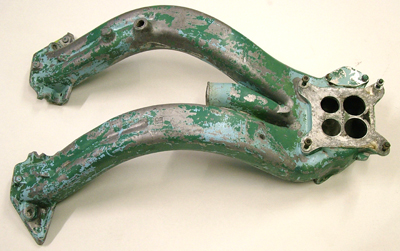
Stock average 247.25 CFM
Stock scatter 235-257 CFM 22 CFM Spread
Notes: This was the short ram version. Individual runner lengths were 11.5. From the plenum to the gasket surface was 25. The scatter spread is more likely due to the as cast finish of the runner than the shape, cross-sectional area or, (better yet) our old friend core shift (which could be quite bad in an elaborate casting like this).
Big Block NASCAR single plane--Stage 1
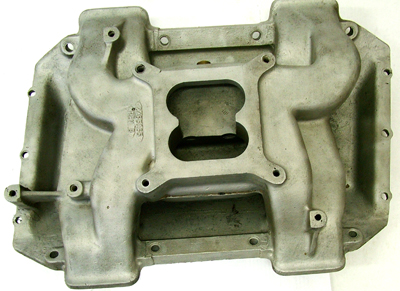
Stock average 283.7 CFM
Stock scatter 266.4-317.9 CFM 51.5 CFM spread
Notes: This had to be from the early 70s when Mopars switched from the Hemi to the big wedge engines. It has an integral valley cover and it has max wedge ports which really help the flow of the intake(Not the heads though!). We see no reason for max wedge ports in the heads, other than to slow the car down.
In the next section, we will show some modification results. We call them our stage 1 modifications (we are not yet finished developing stage II at the time of this writing.)
Here are some surprise pieces; 2x4Bbl and 3x2Bbl--Stage 1
Big Block Edelbrock 2x4Bbl dual plane
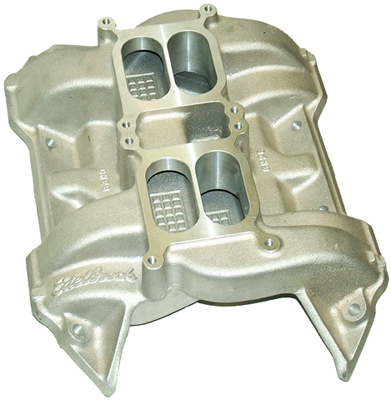
Stock average 286.4 CFM
Stock scatter 273-312 CFM 39 CFM spread
Modified average 294.6 CFM
Modified scatter 287.6-315.0 (27.4 CFM spread)
Notes: For an intake that was basically designed in the 50s, this aint too bad. The average came up only 8 CFM, but the scatter dropped from 34 to 27, very good for this old piece. There is definitely some power waiting here, especially for strokers.
Big Block Edelbrock 6-pack dual plane--Stage 1
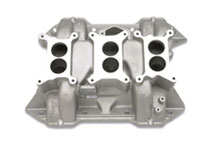
Stock average 302.2 CFM
Stock scatter 272-331 CFM 59 CFM spread
Modified average 332.6 CFM
Modified scatter 306-366 CFM 60 CFM spread
STAGE 2
Average 346 CFM (44CFM more than stock)
Scatter 315-374 CFM (59CFM spread)
Notes: We work on a lot of Big Block 6-pack intakes. They are probably one of our more popular ones to modify. The #1 and #4 ports are hard to improve much and without them in the mix, the modified average goes from 332.6 CFM to 342.5 CFM and the modified scatter goes from 326 CFM to 366 CFM. These are serious numbers for big block intake manifolds, especially ones that can pass for stock. Expect this manifold to get more flow improvement as time passes. We have dynoed a hydraulic cammed 493 cu in with stage 1 version at nearly 700HP.
Big Block CH4B dual planeStage 1
Stock average 273 CFM
Stock scatter 258-286 CFM 28 CFM spread
Modified average 307 CFM
Modified scatter 287.9-337.2 CFM 49.3 CFM spread
Notes: This older manifold points out the difficulty of improving on the older square corner intakes. Some ports improved a lot better than the others. Money would be better spent on a new RPM intake manifold.
TA-DA! Here is the one that everyone is waiting for:
Big block Edelbrock RPM!Stage 1
Stock average 285 CFM
Stock scatter 282-319 CFM 37 CFM spread
Modified average 354 CFM
Modified scatter 325-398 CFM 75 CFM spread
Notes: As one of our more popular intake manifolds, you can expect this manifold to receive more than its share of continued R&D. Perfect for our Stage II porting on Edelbrock RPM heads.
M-1 Intake Single plane

Stock average 298 CFM
Stock scatter 282-315 CFM 33 CFM spread
Notes: This is one of those cases where the flowbench does not tell the full story.
On the manifold we tested we had welded up the top of the plenum and runners and reworked that area for a 4150 Holley opening.
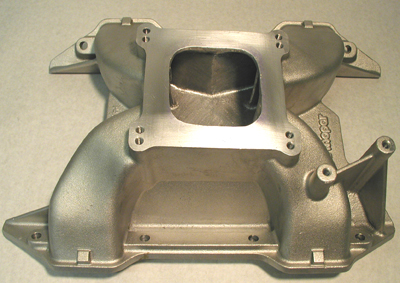
In addition, we blended in the top of the runners nicely into the carb base area. On the dyno and the track, they have always proven to develop more power. However, this modification alone with no runner work did nothing for an airflow increase. What it did do is improve the QUALITY of the air/fuel mixture. The fuel stayed in suspension better, hence more power was developed. The stock 440 Victor intake, Stage 1, would be a better choice from both a cost and power standpoint. With our Stage 1 porting and no plenum work, this M-1 intake could probably flow very well, but without the plenum re-work, the power would not be there. In other words, the Victor is a lower-cost way to get equal or better power. Also see the Holley Street Dominator test results.
Edelbrock Victor 440 Single PlaneStage 1

Stock average 314 CFM
Stock scatter 309-322 CFM 13 CFM difference
Modified average 369 CFM
Modified scatter 351-379 CFM 28 CFM difference
This is one of the few intakes that is up to the challenge of flowing with the current crop of aluminum heads on the market. With our Stage II work, this intake should be near 390 CFM on all ports and bring their spread closer together.
Holley Street Dominator B/B

Stock average 282.3 CFM Stock scatter 278.8-287.4 8.6 CFM difference
This manifold is designed for a spread bore carburetor, like the M-1. We modified our manifold for a square bore carb and the flow only came up to:
Modified average 288
Modified scatter 281.2-298.6 17.4 CFM difference
These are similar to the same results on an M-1. However, remember this modification does produce power, but relatively little airflow. Again, like the M-1, your money would be better spent on the Edelbrock Victor intake.
Weiand Team G B/B with 4150 base

Stock average 339.5
Stock scatter 312.7-374.5 61.8 CFM difference (wow!)
There again is another case of where the flow bench does not tell the whole (or hole) story. This intake would appear to flow a lot of air, in fact, quite a bit more than the 440 Victor. With the spread being so terrible, we would be a little hesitant to chalk it all up to core shift, because only one port flowed 374.5 and it was 22 CFM above the next highest port. I would be more inclined to believe it was designed (or mis-designed) this way, with this much spread. Why doesnt this have the power of the Victor? This intake falls into what we call the square corner intakes. The fuel/air separation is bad in them, so more power is lost in the separation than is picked up in the greater airflow. Use an Edelbrock Victor!
Weiand Team G with Dominator Flange

Stock average 296.1 CFM
Stock scatter 265.6-328.4 32.3 CFM difference
I am not a fan of Dominator type intake manifolds. I see them as a convenient way to cram a dominator carb under the hood instead of using adapters, like you should. It costs you horsepower (notice that it flowed considerably less than its counterpart with the 4150 flange), but it sure looks impressive (not to me) and I wont waste any more time or web space on them. If you are serious, you will do it right!
Stock average 297.5 CFM
Stock scatter 270.7-317.1 46 CFM difference (Ouch!)
This might be considered a tweener manifold. It is between the RPM and Victor manifold. It has way too much spread for a single plane (even one with extreme core shift), but it will fit under a lot of hoods. If we can bring the spread closer together and get the average flow up to the 350 CFM range, this might find a home under more hoods. When time permits, well see what we can do.
Max Wedge Cross Ram, 440 port size, 1962-1964 style

Stock average 282 CFM
Stock scatter 260-295 CFM 35 CFM spread
These manifolds are definitely better looking than they are at producing power.
Stock average282 CFM Stock scatter260-295 CFM35 CFM spread These manifolds are definitely better looking than they are at producing power.
Indy Dual-Plane, 440 Port size
 Stock average 326.5 CFM
Stock scatter 299.6-341.0 CFM 41.4 CFM spread
Notes: This manifold has some very large ports, a good choice for a stroker with hood clearance problems. It is only about .225 taller than the stock cat iron intake manifold. The drawback with this intake is the terrible core shift at the gasket surface. It must be repaired/upgraded with our deep port match and epoxy work.
Stock average 326.5 CFM
Stock scatter 299-341 CFM 42 CFM spread
Modified average 358.9 CFM
Modified scatter 315-388 CFM 73 CFM spread
Indy Single Plane-- Max Wedge Ports

Stock average 461.8 CFM
Stock scatter 452-479CFM 27 CFM spread
I hesitate to include this intake because it is not relative to all the other intakes shown here. It has the huge max-wedge parts, which you can plainly see have a tremendous advantage over the standard port size (on the manifold only, not so for the heads). The manifold should not be used with a cylinder head that uses 440-sized ports.
Mopar Performance Cross Ram Max Wedge 2X4 Casting# 2402726-IM
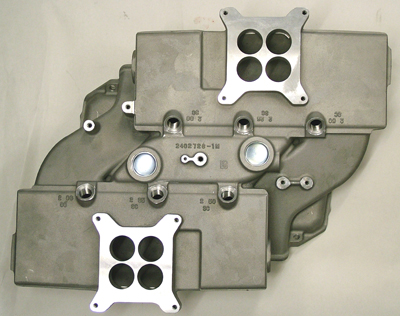
Stock average 309CFM
Stock scatter 305-313 CFM 8CFM (Very Good!)
Please note that this is a Max-Wedge intake with huge ports. Not to be used with 440 port size heads. The flow is about the same as the 440 Victor and there is not a lot of room to improve this intake.
I have promised this manifold update for about 20 months, so we are putting this on the website as it is and we are still not finished. Notice that there are no small blocks shown here---yet, but as they say in the movies COMING SOON! To those of you who call every month asking where it is, thank you for your patience. We are now porting intake manifolds, and have seen exciting results. Remember, what you get from a ported intake manifold cannot be obtained any other way.
All of this leads us to a word that has been thrown around for years.Coreshift.
Coreshift is a problem that occurs in all cast parts. To understand how & why it happens you must understand a little about the casting business.
A pattern of the part is made out of wood (or nowadays by using stereo lithographydont ask). This pattern is laid onto a bed of core sand in a core box. The sand is baked to hold its shape when the pattern is removed. The pattern, in most cases, is several pieces locked together. In most cases there are 2 core boxes required to make the final pattern. The molten aluminum, or cast iron, is poured in and allowed to cool. The core boxes are then shaken, not stirred, to break down the sand back into individual grains. At this point the cast piece is removed. As you can see there are several steps that open the door to misalignment or what we know as coreshift. To be fair to the foundry industry, they have come a long way in a hot & dirty business. So much so that the only people affected by coreshift are a bunch of knit picky racers..and they dont countexcept here at Hughes Engines and at the racetrack.
What coreshift does is alter the port shape and alignment in manifolds and cylinder heads. This shift always causes a reduction as far as airflow and power are concerned.
Ports are designed by porting shops, like us, to have a certain design, shape, size & volume. Any deviation from this will affect the ports function in a negative manner. This is true with either a dry or wet flow scenario.
With regards to cylinder heads in particular the coreshift can be enough to cause some of the area of the port to require no metal removal and in some cases to even need to be filled in with epoxy or weld. Naturally the opposite wall will need considerable metal removal. All this is done to bring the port.
| 


